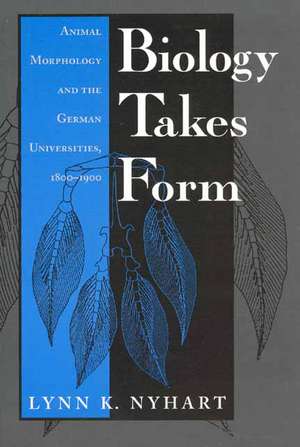Biology Takes Form: Animal Morphology and the German Universities, 1800-1900: Science and Its Conceptual Foundations series
Autor Lynn K. Nyharten Limba Engleză Paperback – 18 oct 1995
Morphology—the study of form—is often regarded as a failed science that made only limited contributions to our understanding of the living world. Challenging this view, Lynn Nyhart argues that morphology was integral to the life sciences of the nineteenth century. Biology Takes Form traces the development of morphological research in German universities and illuminates significant institutional and intellectual changes in nineteenth-century German biology.
Although there were neither professors of morphology nor a morphologists' society, morphologists achieved influence by "colonizing" niches in a variety of disciplines. Scientists in anatomy, zoology, natural history, and physiology considered their work morphological, and the term encompassed research that today might be classified as embryology, systematics, functional morphology, comparative physiology, ecology, behavior, evolutionary theory, or histology. Nyhart draws on research notes, correspondence, and other archival material to examine how these scientists responded to new ideas and to the work of colleagues. She examines the intertwined histories of morphology and the broader biological enterprise, demonstrating that the study of form was central to investigations of such issues as the relationships between an animal's structure and function, between an organism and its environment, and between living species and their ancestors.
Although there were neither professors of morphology nor a morphologists' society, morphologists achieved influence by "colonizing" niches in a variety of disciplines. Scientists in anatomy, zoology, natural history, and physiology considered their work morphological, and the term encompassed research that today might be classified as embryology, systematics, functional morphology, comparative physiology, ecology, behavior, evolutionary theory, or histology. Nyhart draws on research notes, correspondence, and other archival material to examine how these scientists responded to new ideas and to the work of colleagues. She examines the intertwined histories of morphology and the broader biological enterprise, demonstrating that the study of form was central to investigations of such issues as the relationships between an animal's structure and function, between an organism and its environment, and between living species and their ancestors.
Din seria Science and Its Conceptual Foundations series
-
 Preț: 230.35 lei
Preț: 230.35 lei -
 Preț: 455.04 lei
Preț: 455.04 lei -
 Preț: 431.17 lei
Preț: 431.17 lei -
 Preț: 288.59 lei
Preț: 288.59 lei -
 Preț: 294.80 lei
Preț: 294.80 lei -
 Preț: 231.00 lei
Preț: 231.00 lei -
 Preț: 191.68 lei
Preț: 191.68 lei -
 Preț: 274.82 lei
Preț: 274.82 lei -
 Preț: 443.89 lei
Preț: 443.89 lei -
 Preț: 358.60 lei
Preț: 358.60 lei -
 Preț: 301.88 lei
Preț: 301.88 lei -
 Preț: 498.55 lei
Preț: 498.55 lei -
 Preț: 392.61 lei
Preț: 392.61 lei -
 Preț: 352.99 lei
Preț: 352.99 lei -
 Preț: 347.24 lei
Preț: 347.24 lei -
 Preț: 320.04 lei
Preț: 320.04 lei -
 Preț: 389.89 lei
Preț: 389.89 lei -
 Preț: 317.33 lei
Preț: 317.33 lei -
 Preț: 496.35 lei
Preț: 496.35 lei -
 Preț: 435.78 lei
Preț: 435.78 lei -
 Preț: 401.43 lei
Preț: 401.43 lei -
 Preț: 447.32 lei
Preț: 447.32 lei -
 Preț: 387.98 lei
Preț: 387.98 lei -
 Preț: 233.11 lei
Preț: 233.11 lei -
 Preț: 385.65 lei
Preț: 385.65 lei -
 Preț: 331.75 lei
Preț: 331.75 lei -
 Preț: 270.07 lei
Preț: 270.07 lei -
 Preț: 268.20 lei
Preț: 268.20 lei - 15%
 Preț: 194.45 lei
Preț: 194.45 lei - 22%
 Preț: 689.51 lei
Preț: 689.51 lei - 23%
 Preț: 583.39 lei
Preț: 583.39 lei - 10%
 Preț: 306.24 lei
Preț: 306.24 lei - 15%
 Preț: 264.92 lei
Preț: 264.92 lei
Preț: 448.30 lei
Nou
Puncte Express: 672
Preț estimativ în valută:
85.79€ • 91.73$ • 71.52£
85.79€ • 91.73$ • 71.52£
Carte tipărită la comandă
Livrare economică 18 aprilie-02 mai
Preluare comenzi: 021 569.72.76
Specificații
ISBN-13: 9780226610887
ISBN-10: 0226610888
Pagini: 428
Ilustrații: 9 halftones, 1 map 7 line drawings, 3 tables
Dimensiuni: 152 x 229 x 33 mm
Greutate: 0.7 kg
Ediția:1
Editura: University of Chicago Press
Colecția University of Chicago Press
Seria Science and Its Conceptual Foundations series
ISBN-10: 0226610888
Pagini: 428
Ilustrații: 9 halftones, 1 map 7 line drawings, 3 tables
Dimensiuni: 152 x 229 x 33 mm
Greutate: 0.7 kg
Ediția:1
Editura: University of Chicago Press
Colecția University of Chicago Press
Seria Science and Its Conceptual Foundations series
Notă biografică
Lynn K. Nyhart is associate professor in the Department of the History of Science at the University of Wisconsin-Madison.
Cuprins
List of Illustrations
Acknowledgments
Abbreviations
1: Situating Morphology
Pt. 1: Morphology and Physiology
2: The Study of Form before 1850
3: Rearranging the Sciences of Animal Life, 1845-1870
Pt. 2: Evolutionary Morphology, 1860-1880
4: Descent and the Laws of Development
5: Evolutionary Morphology at Jena
6: Evolution and Morphology among the Zoologists, 1860-1880
7: Evolutionary Morphology in Anatomy: Carl Gegenbaur and His School
Pt. 3: Morphology and Biology, 1880-1900
8: The Kompetenzkonflikt within the Evolutionary Morphological Program
9: New Approaches to Form, 1880-1900: Rhetoric, Research, and Rewards
10: Morphology, Biology, and the Zoological Professoriate
11: Morphology and Disciplinary Development: Observations and Reflections
App. 1. Anatomy and Zoology Professors, 1810-1918, by Birthdate
App. 2. Professorships in Zoology, 1810-1918
App. 3. Professorships in Anatomy, 1810-1918
Archival Sources
Bibliography
Index
Acknowledgments
Abbreviations
1: Situating Morphology
Pt. 1: Morphology and Physiology
2: The Study of Form before 1850
3: Rearranging the Sciences of Animal Life, 1845-1870
Pt. 2: Evolutionary Morphology, 1860-1880
4: Descent and the Laws of Development
5: Evolutionary Morphology at Jena
6: Evolution and Morphology among the Zoologists, 1860-1880
7: Evolutionary Morphology in Anatomy: Carl Gegenbaur and His School
Pt. 3: Morphology and Biology, 1880-1900
8: The Kompetenzkonflikt within the Evolutionary Morphological Program
9: New Approaches to Form, 1880-1900: Rhetoric, Research, and Rewards
10: Morphology, Biology, and the Zoological Professoriate
11: Morphology and Disciplinary Development: Observations and Reflections
App. 1. Anatomy and Zoology Professors, 1810-1918, by Birthdate
App. 2. Professorships in Zoology, 1810-1918
App. 3. Professorships in Anatomy, 1810-1918
Archival Sources
Bibliography
Index











